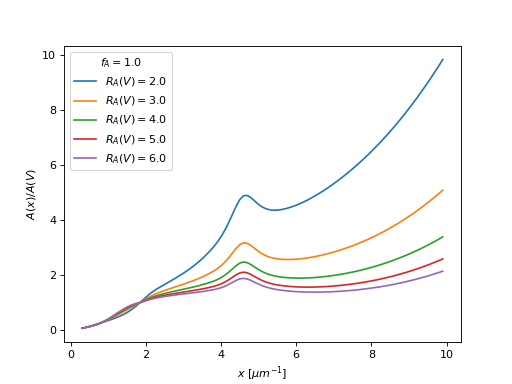G16¶
- class dust_extinction.parameter_averages.G16(**kwargs)[source]¶
Bases:
BaseExtRvAfAModelGordon et al (2016) Milky Way, LMC, & SMC R(V) and f_A dependent model
Mixture model between the F99 R(V) dependent model (component A) and the G03_SMCBar model (component B)
- Parameters:
- RvA: float
R_A(V) = A(V)/E(B-V) = total-to-selective extinction R(V) of the A component
- fA: float
f_A is the mixture coefficent between the R(V)
- Raises:
- InputParameterError
Input RvA values outside of defined range Input fA values outside of defined range
Notes
From Gordon et al. (2016, ApJ, 826, 104)
Example showing G16 curves for a range of R_A(V) values and f_A values.
import numpy as np import matplotlib.pyplot as plt import astropy.units as u from dust_extinction.parameter_averages import G16 fig, ax = plt.subplots() # temp model to get the correct x range text_model = G16() # generate the curves and plot them x = np.arange(text_model.x_range[0], text_model.x_range[1],0.1)/u.micron Rvs = ['2.0','3.0','4.0','5.0','6.0'] for cur_Rv in Rvs: ext_model = G16(RvA=cur_Rv, fA=1.0) ax.plot(x,ext_model(x),label=r'$R_A(V) = ' + str(cur_Rv) + '$') ax.set_xlabel(r'$x$ [$\mu m^{-1}$]') ax.set_ylabel(r'$A(x)/A(V)$') ax.legend(loc='best', title=r'$f_A = 1.0$') plt.show()
(
Source code,png,hires.png,pdf)
import numpy as np import matplotlib.pyplot as plt import astropy.units as u from dust_extinction.parameter_averages import G16 fig, ax = plt.subplots() # temp model to get the correct x range text_model = G16() # generate the curves and plot them x = np.arange(text_model.x_range[0], text_model.x_range[1],0.1)/u.micron fAs = [0.0, 0.2, 0.4, 0.6, 0.8, 1.0] for cur_fA in fAs: ext_model = G16(RvA=3.1, fA=cur_fA) ax.plot(x,ext_model(x),label=r'$f_A = ' + str(cur_fA) + '$') ax.set_xlabel(r'$x$ [$\mu m^{-1}$]') ax.set_ylabel(r'$A(x)/A(V)$') ax.legend(loc='best', title=r'$R_A(V) = 3.1$') plt.show()
(
Source code,png,hires.png,pdf)
Attributes Summary
Methods Summary
evaluate(in_x, RvA, fA)G16 function
Attributes Documentation
- RvA_range = [2.0, 6.0]¶
- fA_range = [0.0, 1.0]¶
- x_range = [0.3, 10.0]¶
Methods Documentation
- static evaluate(in_x, RvA, fA)[source]¶
G16 function
- Parameters:
- in_x: float
expects either x in units of wavelengths or frequency or assumes wavelengths in wavenumbers [1/micron]
internally wavenumbers are used
- Returns:
- axav: np array (float)
A(x)/A(V) extinction curve [mag]
- Raises:
- ValueError
Input x values outside of defined range